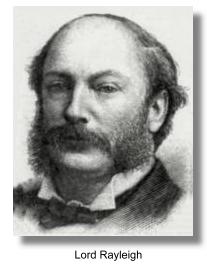 Lord Rayleigh was born John William Strutt into a barony begun in 1821 on the occasion of King George IV's coronation. He was the eldest of seven children, born on the 12th November 1842. His father, John James Strutt, had been Second Baron for only six years, during which time he had married Clara Latouche Vicars, a lady over twenty five years his junior.
Lord Rayleigh was born John William Strutt into a barony begun in 1821 on the occasion of King George IV's coronation. He was the eldest of seven children, born on the 12th November 1842. His father, John James Strutt, had been Second Baron for only six years, during which time he had married Clara Latouche Vicars, a lady over twenty five years his junior.
His inquisitive scientific mind showed itself when he was four (despite the fact that he had seemed rather unintelligent when he was unable to speak at the age of almost three). His aunt Emily complained at his constant questioning, such as: "What becomes of the water spilt on the tablecloth after it has dried up?"
He attended Eton College at ten years of age, only to catch smallpox, and then whooping cough. His parents decided a home education would be best, and so a private tutor educated him in mathematics, trigonometry and statics. His short stay at Harrow (West Acre, 18571 - 18572) was his last at school, as he caught a chest infection which left him in ill health for the rest of his life.
He was taught from the ages of fourteen to eighteen by Rev. G.T. Warner at Torquay. He entered Trinity College, Cambridge in October 1861 having passed his entrance exams with great success. His mathematics course was vital to his future career in understanding physics. He graduated in 1865 with awards which displayed his promise, a promise which he amply fulfilled. He gained a fellowship at the college the following year, which he held for five years before he married. In 1873 his father died, so he became Third Baron Rayleigh and inherited Terling Place, Essex, as well. For the next three years he felt compelled to look after the estate so his scientific research was little. In 1876, he left the job to his younger brother.
He spent five years as the second Cavendish Professor of Physics at Cambridge. He first researched optics and vibrations, both rather mathematical topics. Later he considered physics as a field of work in itself and investigated wave theory, light scattering, electrodynamics, hydrodynamics, viscosity and photography. His careful, precise work led to the establishment of standards for resistance, current and electromotive force. Lord Rayleigh was the cause of a radical new way of instruction of physics experiments at Cambridge, increasing his students from six to seventy. After Cambridge, Rayleigh returned to his country seat. For much of his career he divided his time between his laboratory at Terling Place and the Royal Institution in London where he was Professor of Natural Philosophy from 1887 to 1905. The experiments for the isolation of argon, for instance, were first carried out at the Royal Institution, but the final production was made at Terling Place.
Lord Rayleigh's first researches were mainly mathematical, concerning optics and vibrating systems, but his later work ranged over almost the whole field of physics, covering sound, wave theory, colour vision, electrodynamics, electromagnetism, light scattering, flow of liquids, hydrodynamics, density of gases, viscosity, capillarity, elasticity, and photography. His patient and delicate experiments led to the establishment of the standards of resistance, current, and electromotive force; and his later work was concentrated on electric and magnetic problems. Lord Rayleigh was an excellent instructor and, under his active supervision, a system of practical instruction in experimental physics was devised at Cambridge, developing from a class of five or six students to an advanced school of some seventy experimental physicists. His Theory of Sound was published in two volumes during 1877-1878. Volume I covers harmonic vibrations, systems with one degree of freedom, vibrating systems in general, transverse vibrations of strings, longitudinal and torsional vibrations of bars, vibrations of membranes and plates, curved shells and plates, and electrical vibrations. Volume II covers aerial vibrations, vibrations in tubes, reflection and refraction - of plane waves, general equations, theory of resonators, Laplace’s functions and acoustics, spherical sheets of air, vibration of solid bodies, and facts and theories of audition. His other extensive studies are reported in his Scientific Papers - six volumes issued during 1889-1920. He has also contributed to the Encyclopaedia Britannica.
The honours he received for his work were numerous. He was made a Fellow of the Royal Society in 1873, was Secretary between 1885 and 1896, and President between 1905 and 1908. He was made a Privy Counsellor in 1905. The Royal Society awarded him the Copley, Royal and Rumford medals for his work in Physics. All of this was overshadowed by his being awarded the Nobel Prize for Physics in 1904 for the isolation of the inert gas argon. He is the only Old Harrovian to achieve this award.
Rayleigh had three sons, the eldest of whom, Robert John Strutt, succeeded him at his death on 30th June, 1919. The name of Rayleigh in science continued through the Fourth Baron who became Professor of Physics at Imperial College of Science and Technology, London. However, the work of his father is far more famous and few physicists, and no Old Harrovians, have had quite as dramatic and lasting effect on the world of science.
Back to History of Ultrasound in Obstetrics and Gynecology.